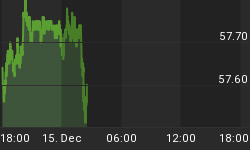Goldman Sachs has been predicting the demise of gold for the past few years. Back in July of 2015, Jeff Currie (Global Head of Commodities Research at the investment firm) went on record predicting the price of the yellow metal would fall below $1,000 per ounce by the start of 2016. However, that prediction failed to materialize; despite the fact that gold was already below $1,100 at the time he made the call.
Nevertheless, being wrong on the direction of gold last year did not prevent him from once again urging investors to short the commodity in February of this year; claiming it would fall to $1,000 per ounce within 12 months. His rationale for anticipating the price decline is that gold is primarily a "safe haven" asset in times of economic and market turmoil and that the U.S. faced very little recession risk -- so there is no reason for investors to seek the shelter of gold.
However, Goldman Sachs, which is a bastion of Keynesian apologists--like most on Wall Street, fails to grasp what really drives the price of gold...and what has caused it to surge 18% so far in 2016.
Gold is not merely a "safe haven" asset; it is rather the best form of money know to humankind because of its scarcity and indestructibility. Financial houses hate gold because it tends to do best when the securities they sell head south. And governments hate gold because it best reveals the persistent destruction of the purchasing power of the middle class through central bank debt monetization.
The major rationale Wall Street has used for years to eschew the metal is that it pays no interest. After all, why own an asset that pays you nothing if you can safely earn money on bank deposits and short-term sovereign debt? But now this is no longer true. With negative interest rates on sovereign debt and near-zero percent customer deposit rates now the norm, there are no lost opportunity costs for owning gold.
More importantly, with $7 trillion (30%) worth of the developed world's sovereign debt trading with a negative yield, you don't even need there to be any inflation to cause real yields to become negative. Inflation has traditionally been great for gold because it is a necessary ingredient to push positive nominal rates down into negative territory. And, of course, when your real return on cash is negative, investors flock to a commodity that has a long history of retaining its purchasing power. What Goldman fails to recognize is that since central banks have already pushed rates into the basement, inflation need not be present to make real interest rates negative.
Therefore, the argument against gold has completely flip-flopped. Now investors realize the perceived "safety" of holding sovereign debt is no longer there since you are guaranteed to lose money on your principal when holding it to maturity?
What's worse is that central bankers are moving further into unchartered territory in pursuit of their inflation targets. ECB head, Mario Draghi, recently increased his QE level to 80 billion euros per month, from 60 billion, and is now buying corporate debt to achieve a sustainable degree of inflation. In fact, central banks around the world have vowed to do "whatever it takes" to reach a 2% inflation target. Hence, investors will soon have to subtract 2%--at a minimum -- from the already negative yields on sovereign debt and zero offering on money market funds to calculate their real return.
Gold is surging in this environment because citizens across the globe are facing a huge loss in the real purchasing power of their savings.
In this new Keynesian dystopia, growth and inflation are deemed as one and the same. Their game plan for success is simple: print money to create inflation. This will boost asset prices and lower borrowing costs, which will, in turn, lead to more debt creation. And more debt outstanding will eventually -- according to these Keynesians--boost aggregate demand and cause economic growth.
But the most pernicious part of being an addict is that it takes more and more of the substance to achieve the desired result. Global economies have become a bunch of debt addicts and governments are finding it necessary to constantly lower borrowing costs in order to force more loans onto the debt-disabled public and private sectors.
Mr. Currie and Goldman Sachs fail to understand that negative nominal rates coupled with rising inflation expectations are the rocket fuel for gold--especially since central banks are trapped in this vortex of persistently reducing the value of their currencies vis a vis their trading partners. Even our Federal Reserve found it necessary to renege on its plan to raise rates four times this year after the markets fell apart in January.
But from this folly there is no end. The intervention of central banks in the capital markets has become so extreme that they are now incapable of selling their securities and fighting inflation without sending equities and bond prices crashing. In effect, the inevitable binary outcomes have now become intractable inflation or depression. And this is the real reason why the bull market in precious metals has just begun.















